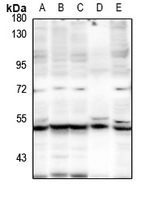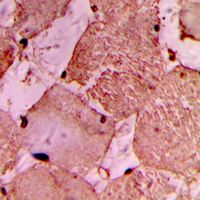Anti-IDOL Antibody
Rabbit polyclonal antibody to IDOL
- SPECIFICATION
- CITATIONS
- PROTOCOLS
- BACKGROUND

Application
| WB, IHC |
|---|---|
| Primary Accession | Q8WY64 |
| Other Accession | Q8BM54 |
| Reactivity | Human, Mouse, Rat, Monkey, Bovine |
| Host | Rabbit |
| Clonality | Polyclonal |
| Calculated MW | 49910 Da |
| Gene ID | 29116 |
|---|---|
| Other Names | BZF1; IDOL; E3 ubiquitin-protein ligase MYLIP; Inducible degrader of the LDL-receptor; Idol; Myosin regulatory light chain interacting protein; MIR |
| Target/Specificity | KLH-conjugated synthetic peptide encompassing a sequence within the center region of human IDOL. The exact sequence is proprietary. |
| Dilution | WB~~WB (1/500 - 1/1000), IH (1/100 - 1/200) IHC~~1:100~500 |
| Format | Liquid in 0.42% Potassium phosphate, 0.87% Sodium chloride, pH 7.3, 30% glycerol, and 0.09% (W/V) sodium azide. |
| Storage | Store at -20 °C.Stable for 12 months from date of receipt |
| Name | MYLIP |
|---|---|
| Synonyms | BZF1, IDOL |
| Function | E3 ubiquitin-protein ligase that mediates ubiquitination and subsequent proteasomal degradation of myosin regulatory light chain (MRLC), LDLR, VLDLR and LRP8. Activity depends on E2 enzymes of the UBE2D family. Proteasomal degradation of MRLC leads to inhibit neurite outgrowth in presence of NGF by counteracting the stabilization of MRLC by saposin-like protein (CNPY2/MSAP) and reducing CNPY2-stimulated neurite outgrowth. Acts as a sterol-dependent inhibitor of cellular cholesterol uptake by mediating ubiquitination and subsequent degradation of LDLR. |
| Cellular Location | Cytoplasm. Cell membrane; Peripheral membrane protein |
| Tissue Location | Ubiquitously expressed. |

Thousands of laboratories across the world have published research that depended on the performance of antibodies from Abcepta to advance their research. Check out links to articles that cite our products in major peer-reviewed journals, organized by research category.
info@abcepta.com, and receive a free "I Love Antibodies" mug.
Provided below are standard protocols that you may find useful for product applications.
Background
KLH-conjugated synthetic peptide encompassing a sequence within the center region of human IDOL. The exact sequence is proprietary.
If you have used an Abcepta product and would like to share how it has performed, please click on the "Submit Review" button and provide the requested information. Our staff will examine and post your review and contact you if needed.
If you have any additional inquiries please email technical services at tech@abcepta.com.













 Foundational characteristics of cancer include proliferation, angiogenesis, migration, evasion of apoptosis, and cellular immortality. Find key markers for these cellular processes and antibodies to detect them.
Foundational characteristics of cancer include proliferation, angiogenesis, migration, evasion of apoptosis, and cellular immortality. Find key markers for these cellular processes and antibodies to detect them. The SUMOplot™ Analysis Program predicts and scores sumoylation sites in your protein. SUMOylation is a post-translational modification involved in various cellular processes, such as nuclear-cytosolic transport, transcriptional regulation, apoptosis, protein stability, response to stress, and progression through the cell cycle.
The SUMOplot™ Analysis Program predicts and scores sumoylation sites in your protein. SUMOylation is a post-translational modification involved in various cellular processes, such as nuclear-cytosolic transport, transcriptional regulation, apoptosis, protein stability, response to stress, and progression through the cell cycle. The Autophagy Receptor Motif Plotter predicts and scores autophagy receptor binding sites in your protein. Identifying proteins connected to this pathway is critical to understanding the role of autophagy in physiological as well as pathological processes such as development, differentiation, neurodegenerative diseases, stress, infection, and cancer.
The Autophagy Receptor Motif Plotter predicts and scores autophagy receptor binding sites in your protein. Identifying proteins connected to this pathway is critical to understanding the role of autophagy in physiological as well as pathological processes such as development, differentiation, neurodegenerative diseases, stress, infection, and cancer.



